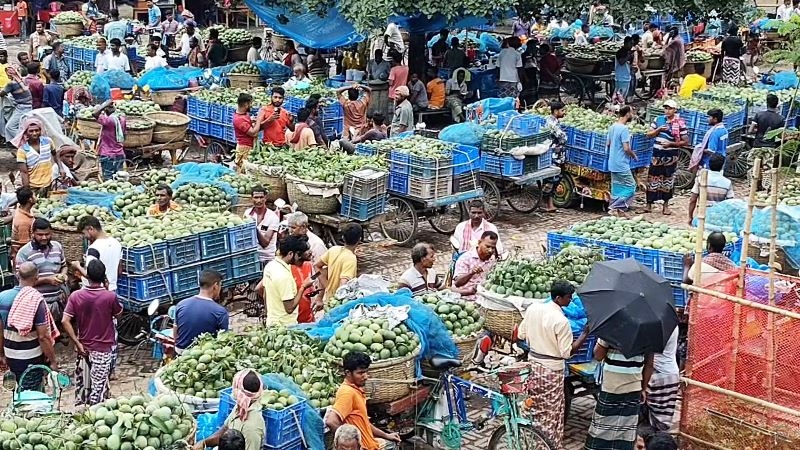- CA Yunus pays homage to Liberation War martyrs on Victory Day |
- Bangladesh capital market extends losing streak for second day |
- Bangladesh celebrates Victory Day Tuesday |
- 'Different govts presented history based on their own ideologies': JU VC |
Chapainawabganj mango farmers struggle amid bumper harvest

Mango market in Chapainawabganj on Monday 23 June 2025
By Nasim Mahmud
Chapainawabganj, June 24 - As the mango season brings colour and celebration to Chapainawabganj, a quiet struggle hides beneath the festive mood, often going unnoticed.
This year’s harvest in Bangladesh’s mango capital is nothing short of abundant. The orchards are heavy with luscious varieties—Khirsapat, Langra, Amrapali, Banana Mango, and the majestic Fazli—while the ever-popular Gopalbhog has already bid farewell for the season.
Markets in Kansat, Bholahat, and Rahanpur are awash with activity, drawing traders from Dhaka and beyond, eager to procure the prized fruit.
From dawn till dusk, these trading hubs echo with the sounds of bargaining and the rustle of crates being loaded.
Mangoes are currently fetching between Tk 600 and Tk 4,000 per maund, depending on their type and quality. Yet this apparently thriving trade belies the frustration brewing in the hearts of local growers.
For all its visual splendour, this season has been fraught with challenges. Adverse weather at the beginning, combined with an extended Eid holiday, transport hurdles, and sweltering temperatures, caused several varieties to ripen simultaneously. This glut in supply stifled prices, leaving farmers unable to reap the rewards of their labour.
“Even though the yield is better this year, the prices are badly lower than last year,” lamented Abdur Rakib, a seasoned mango grower from the district.
“On top of that, the cost of fertilisers, pesticides, irrigation, and labour has gone up, making it difficult for us to break even,” he said.
Rakib painted a stark comparison, saying, Khirsapat mangoes, which launched the season at Tk 1,500–1,600 per maund, had sold for Tk 2,900–3,000 at the same time last year.
“Now that Khirsapat is almost over, the remaining mangoes in the orchards are very few. If prices were high at the beginning, farmers would have benefitted. Even though prices are improving now, there’s not enough mango left to make a profit,” he said.
Elsewhere, Fazli mangoes are being sold at Tk 1,200–1,300 per maund, down from last year’s opening rate of Tk 1,500–1,600. Langra, another beloved variety, commands between Tk 1,200 and Tk 1,400—barely half of the Tk 3,000 some fetched just a year ago.
Rakib also pointed to the recent rainfall as another cruel twist in the season’s tale. “The mangoes are developing spots and cracks due to the rain. Farmers are being forced to harvest early out of fear of further damage, and as a result, they are not getting good prices.”
Irfan, another grower, echoed the sentiment, blaming both erratic weather and the prolonged Eid holidays. “When farmers were supposed to harvest before Eid, the rains began. When the rain stopped, Eid had arrived, causing market closures for several days. By the time trading resumed, the rain returned, damaging the mangoes.”
He went on to say, “Even though production was good, we’re losing money because of the low prices and rain-damaged mangoes,” added Kabir, another cultivator, his voice edged with anxiety.
The Department of Agricultural Extension (DAE) is not unaware of the plight. Dr Yasin Ali, the district’s Deputy Director, acknowledged the concerns, saying, “Mangoes are highly perishable and ripen quickly after harvesting, making timely sale crucial. Before Eid-ul-Adha, the high temperatures accelerated the ripening process, forcing farmers to harvest quickly. But during the Eid holidays, many Dhaka residents left the city, causing demand to drop. As a result, mango prices were low during that period.”
“Now that the holidays are over, demand has picked up again and prices have slightly improved. But I believe the prices need to increase further to ensure farmers can make a profit and recover their investment,” he said.
According to the agriculture department, mangoes were cultivated on 37,504 hectares in Chapainawabganj this season, with a production target of 386,590 metric tonnes—a noticeable increase from last year’s 348,000 tonnes.
Agricultural experts now urge the government to step in, suggesting measures to bolster mango exports and invest in fruit processing industries.
Without such interventions, they warn, the region’s farmers may lose their appetite for cultivation in future seasons.
For now, Chapainawabganj stands draped in green and gold, its trees heavy with promise and its farmers light with profit. A season of abundance has, paradoxically, become a season of loss. - UNB

